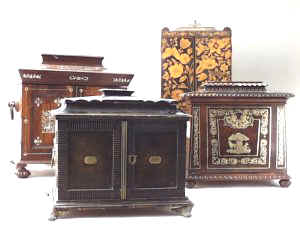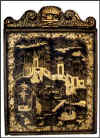 |
ANTIQUE BOXES
at the Sign
of the Hygra
2 Middleton Road
London E8 4BL
Tel: 00 44 (0)20 7 254 7074
Fax: 00 44 (0) 870 1257669
email: boxes@hygra.com |
Antique Boxes in English Society
1760 -1900
by
ANTIGONE
TABLE CABINETS |
News
| Buying
| Contact us
| Online History of boxes
| The Schiffer Book | Advanced
Search
The highly skilled cabinet makers who made boxes in the 18th and 19th centuries
also made table cabinets. These small versions of furniture were made to
stand on tables, desks, in alcoves and on shelves. They were used both
for storing a variety of items and for enhancing dull corners.
|
 |
Most table cabinets consist of a set of drawers enclosed by two doors. Some
have a lift up lid which when opened reveals the contents of the top tray
and some have a pull out writing slope on the bottom drawer.
The styles of the table cabinets follow in the footsteps of furniture and
boxes of the parallel periods with the exception that the sides are always
straight. The tops however are sometimes domed or stepped as in Regency period
boxes. They sometimes stand on pediments or feet and have side handles.
18th century table cabinets are rectangular in figured mahogany veneers edged
in boxwood. Occasionally they are inlaid in the motifs found on
tea caddies of the period.
Chinoiserie and penwork table cabinets were
also made in the eighteen century.
REGENCY
In the early part of the 19th century cabinets were decorated in many of
the fashions of the time.
Penwork cabinets were sometimes made with
domed or stepped tops and were decorated both on the outside and the inside
drawers. They were often made to contain sewing tools on the top section
which opened from the top like a box. The rest of the drawers were usually
empty.
Chinoiserie and Painted cabinets followed similar patterns.
Tunbridge Ware cabinets dating from this period
are magnificently decorated with parquetry and vandyke patterns. The large
surfaces gave the maker the opportunity to show off not only his skill but
the wonderful range of timbers he had at his disposal.
Wonderful Chinese lacquer cabinets were imported
by the beginning of the 19th century. The decoration on these is of very
fine quality. They usually stand on a pedestal and have two doors. The top
is shaped in proportion with the base. Inside there are four five or six
drawers with turned ivory knobs. The drawers too are decorated with designs
in gold.
|
 |
A few Chinese cabinets were made in the English arrangement, that is with
the top opening like the lid of a box. Even fewer with the additional writing
slope pulling out of the bottom drawer. These are of the highest quality
and are now very rare.
1830s
By the end of the Regency period in the 1830s another style of table cabinet
superseded the English wooden cabinets.
These table cabinets often referred to as William IV, are in figured rosewood
with elaborate mother of pearl inlays. They stand on stepped pedestals and
have architecturally structured tops which open like box lids. The top section
is fitted like a work box or sewing box of
the period. The second or third drawer has a tray fitted for holding jewellery
and the fourth (last) drawer pulls out and opens up to a writing slope. There
are of course variations but on the whole all of these table cabinets are
very impressive.
Papier mâchè table cabinets of
this period follow the decorative patterns of work boxes. They were made
in both forms, that is as a set of drawers enclosed by doors, or the top
opening up separately and fitted with sewing equipment. The tops are flat,
domed or stepped with surrounds in fluid rounded forms. The bases are quite
deep and shaped
MID to END 19th CENTURY
By this time, table cabinets in wood became simpler. They were made in figured
walnut or coromandel in rectangular shapes. Straight doors enclosed brass
handled drawers. Sometimes the cabinets were surrounded in brass, or had
brass corners in the fashion of writing boxes of the period.
Tunbridge Ware cabinets were now decorated with designs of castles, flowers,
ruins etc in wood mosaic. They were mostly smaller than the earlier cabinets.
Papier mâchè cabinets continued very much in the earlier tradition
but with more prominent mother of pearl decoration. A notable addition was
the Gothic revival cabinets made in rounded and peaked shapes. Papier
mâchè lent itself to being moulded in plastic shapes and this
quality together with the mother of pearl decoration enabled the makers to
interpret this new fashion very effectively.
News
| Buying
| Contact us
| Online History of boxes
| The Schiffer Book | Advanced
Search
© 1999/2000 Antigone Clarke and Joseph O'Kelly
| 